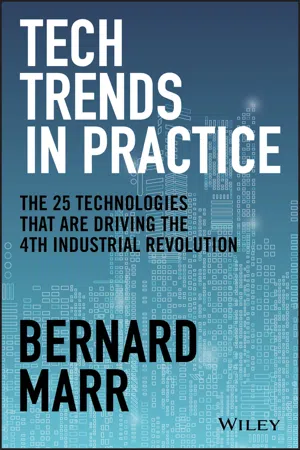
Tech Trends in Practice
The 25 Technologies that are Driving the 4th Industrial Revolution
- English
- ePUB (mobile friendly)
- Available on iOS & Android
Tech Trends in Practice
The 25 Technologies that are Driving the 4th Industrial Revolution
About this book
***BUSINESS BOOK AWARDS - FINALIST 2021*** Discover how 25 powerful technology trends are transforming 21st century businesses
How will the latest technologies transform your business? Future Tech Trends in Practice will give you the knowledge of today's most important technology trends, and how to take full advantage of them to grow your business. The book presents25 real-world technology trends along with their potential contributions to organisational success. You'll learn how to integrate existing advancements and plan for those that are on the way.
In this book, best-selling author, strategic business advisor, and respectedfuturist Bernard Marr explains the role of technology in providing innovative businesses solutions for companies of varying sizes and across different industries. He covers wide-ranging trends and provides an overview of how companies are using these new and emerging technologies in practice.
You, too, can prepare your company for the potential and power of trending technology by examining these and other areas of innovation described in Future Tech Trends in Practice:
- Artificial intelligence, including machine and deep learning
- The Internet of Things and the rise of smart devices
- Self-driving cars and autonomous drones
- 3D printing and additive manufacturing
- Blockchain technology
- Genomics and gene editing
- Augmented, virtual and mixed reality
When you understand the technology trends that are driving success, now and into the future, you'll be better positioned to address and solve problems within your organisation.
Frequently asked questions
- Essential is ideal for learners and professionals who enjoy exploring a wide range of subjects. Access the Essential Library with 800,000+ trusted titles and best-sellers across business, personal growth, and the humanities. Includes unlimited reading time and Standard Read Aloud voice.
- Complete: Perfect for advanced learners and researchers needing full, unrestricted access. Unlock 1.4M+ books across hundreds of subjects, including academic and specialized titles. The Complete Plan also includes advanced features like Premium Read Aloud and Research Assistant.
Please note we cannot support devices running on iOS 13 and Android 7 or earlier. Learn more about using the app.
Information
TREND 1
Artificial Intelligence and Machine Learning
The One-Sentence Definition
What Is Artificial Intelligence and Machine Learning?
How Is Artificial Intelligence and Machine Learning Used in Practice?
Thanks to AI, Machines Can Beat Humans at Games
- In 1997, IBM’s Deep Blue chess-playing machine beat world champion Garry Kasparov.4 Many hailed this as the start of machine intelligence catching up to human intelligence, but the reality is perhaps a little less compelling. Deep Blue used brute force computing power to consider every possible chess move, and that’s how it beat Kasparov. (Discover how machines learned to get a lot more creative at game-playing in Chapter 17.)
- In 2011, IBM’s Watson AI system beat two human contestants at the game show Jeopardy!.5 And not just a...
Table of contents
- Cover
- Title Page
- Copyright
- Dedication
- Introduction
- Trend 1 Artificial Intelligence and Machine Learning
- Trend 2 Internet of Things and the Rise of Smart Devices
- Trend 3 From Wearables to Augmented Humans
- Trend 4 Big Data and Augmented Analytics
- Trend 5 Intelligent Spaces and Smart Places
- Trend 6 Blockchains and Distributed Ledgers
- Trend 7 Cloud and Edge Computing
- Trend 8 Digitally Extended Realities
- Trend 9 Digital Twins
- Trend 10 Natural Language Processing
- Trend 11 Voice Interfaces and Chatbots
- Trend 12 Computer Vision and Facial Recognition
- Trend 13 Robots and Cobots
- Trend 14 Autonomous Vehicles
- Trend 15 5G and Faster, Smarter Networks
- Trend 16 Genomics and Gene Editing
- Trend 17 Machine Co-Creativity and Augmented Design
- Trend 18 Digital Platforms
- Trend 19 Drones and Unmanned Aerial Vehicles
- Trend 20 Cybersecurity and Cyber Resilience
- Trend 21 Quantum Computing
- Trend 22 Robotic Process Automation
- Trend 23 Mass Personalization and Micro-Moments
- Trend 24 3D and 4D Printing and Additive Manufacturing
- Trend 25 Nanotechnology and Materials Science
- A Few Final Words
- About the Author
- Acknowledgments
- Index
- End User License Agreement